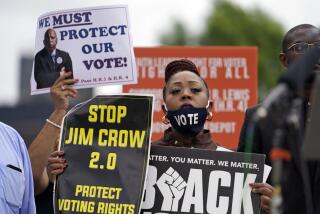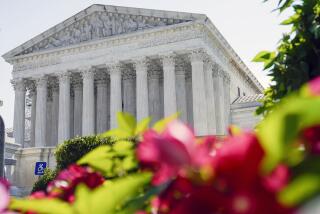Op-Ed: So much for nonpartisan. Republican Supreme Court justices are helping elect Republicans

It is hard to understand the Supreme Court’s ruling on Monday to reinstate a congressional district map drawn by the Alabama Legislature as anything other than an effort by the conservative justices to help Republicans in the midterms.
In a 5-4 decision, with Chief Justice John G. Roberts Jr. joining the three liberal justices in dissent, the court ignored basic principles of law and essentially gave the Republicans another House seat.
Alabama Republicans feared the loss of one congressional seat.
A federal three-judge district court in Alabama (with two Trump appointees and one Clinton appointee), after hearing seven days of testimony and reading more than 1,000 pages of briefs, concluded that the map violated Section 2 of the Voting Rights Act. That provision prohibits state and local governments from having election systems that discriminate against minority voters.
Alabama’s population is 27% Black, but under the map drawn in November, Black voters have the power to elect their preferred candidates in only one of the state’s seven congressional districts. The district court found that the Republican-controlled Legislature could have and should have created a second district with a majority of Black voters. The court then ordered the Legislature to submit new maps by this week or it would appoint an independent expert to do so.
Not one of the nine justices denied the discriminatory effect of the Alabama Legislature’s redistricting. Nor did any of the justices claim that the district court misapplied the law in finding a violation of the Voting Rights Act. As Roberts explained in his dissent, the district court’s ruling contained no errors for correction. In such cases, there is no reason to stay the district court’s ruling because there’s no likelihood that the ruling would be reversed.
Why then did the Supreme Court stay the district court order and allow the Alabama Legislature’s discriminatory map to go into effect?
Justice Brett M. Kavanaugh, in an opinion defending the move, speciously claimed that it was inappropriate to change the rules so soon before an election. But the Legislature’s map was created in November, taking the lawmakers less than a week to draw up the plan, and civil rights advocates filed a lawsuit challenging it within hours of its enactment. This is not a situation where the federal court was acting days or even weeks before the election. The Alabama primary is not until May and the general election is not until November.
Kavanaugh’s argument would make challenges to discriminatory voting districts nearly impossible, at least for the first congressional election after redistricting. New districts cannot be drawn until after the decennial census. If a legislature just delays redistricting long enough, then no federal court can step in to cure the discrimination before the next election.
Under Kavanaugh’s reasoning, if Alabama drew districts that would have made it unlikely that any Black representative could have been elected, there still could be no remedy.
Monday’s ruling means that a map, clearly violating the Voting Rights Act, will be used in this year’s congressional primary and general election.
Time and again the court’s Republicans have issued decisions strongly favoring the GOP in the electoral process. That’s not a coincidence.
This case should be seen as a continuation of conservative efforts to gut the Voting Rights Act. In 2013, in Shelby County vs. Holder, the court, in a 5-4 decision, declared unconstitutional the provisions of the law that required that jurisdictions with a history of race discrimination get preapproval from the U.S. attorney general, called “preclearance,” before enacting significant changes in their election systems. Immediately after that decision, states such as Texas and North Carolina put into place discriminatory laws that had earlier been denied preclearance because of their discriminatory effects against voters of color.
In July 2021, in Brnovich vs. Democratic National Committee, the court, again divided along ideological lines, made it much more difficult to challenge state election laws, even if they clearly have discriminatory effects on voters of color.
Now it appears that the conservatives are ready to limit the use of the Voting Rights Act to prohibit discrimination in redistricting. It is surely not coincidental that all of these rulings by Republican-appointed justices help Republicans in elections and hurt Democrats.
As Justice Elena Kagan wrote in her dissent, this ruling allows to stand a “violation of a law this Court once knew to buttress all of American democracy.” Time and again, the court’s conservatives have shown that they are perfectly willing to ignore this principle.
Erwin Chemerinsky is dean of the UC Berkeley School of Law and a contributing writer to Opinion. He is the author, most recently, of “Presumed Guilty: How the Supreme Court Empowered the Police and Subverted Civil Rights.”
More to Read
A cure for the common opinion
Get thought-provoking perspectives with our weekly newsletter.
You may occasionally receive promotional content from the Los Angeles Times.








